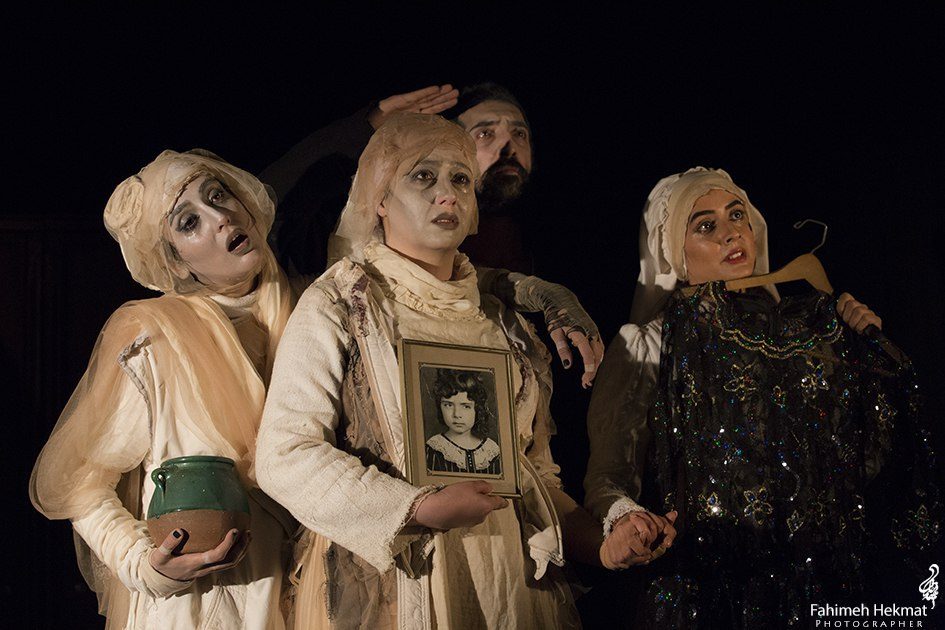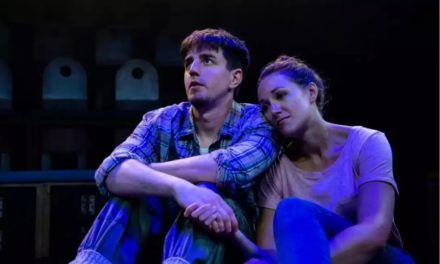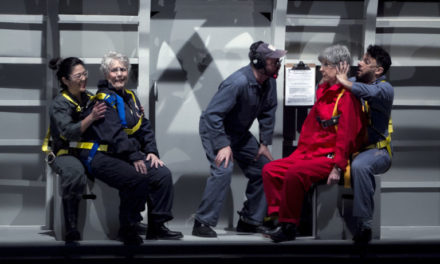The privatization of theatre in Iran has compelled many theatre directors and producers to become preoccupied with generating box-office revenue and adjusting their income and expenses. They have to resort to producing mundane and superficial theatrical products aimed merely at pleasing the tastes of their growing audiences. The recent theatrical scene has also seen an unprecedented increase in the production of inconsistent, pseudo-postmodern re-readings from the dramatic canons. Within the context of this aesthetic and thematic poverty, the play You Were Occupied with Your Dying, written by Kāmrān Shahlāyi and directed by Ms. Mojgān Khāleghi, has set itself free of such market constraints and aesthetic confusion.
A graduate of Theatre Directing from the University of Tehran, Khāleghi (b. 1985) uses a minimal form and simple scenery to retain the freshness of experimental performance in her work, without being trapped by the glittering charms of expensive decor and costumes. The play, which was supported by the Cultural Organization of Isfahan’s Municipality, was staged in Isfahan for twenty-three nights. In Tehran, it was performed in Ghashghāyi Hall, one of the state-owned venues, in July 2018 for thirty nights.
Although not based on a clear story, a hidden plotline can be seen in the multilayered performance of You Were Occupied with Your Dying. It seems the unity of the plotline is exploded and its main lines are scattered, and the creators’ innovative modifications have replaced the direct and explicit indication of scenes with indirect, implied, and multilayered significations. In this sense, the performance has transformed into a series of “scattered narratives” that are supposed to get finalized and complemented in the audience members’ minds and with their imagination’s active participation. The result is a product that is not decorated for easy and fast exhibition and consumption. The direct connections and single, linear significances are clearly disrupted in each part of the performance and then re-arranged in a fresh, distant, and non-continuous way, a process that demands audiences’ mental and intellectual engagement.
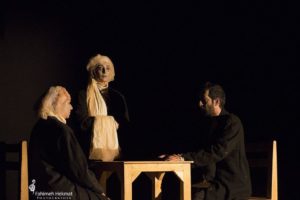
Courtesy of Mojgan Khaleghi
There are two twin sisters, Soha and Sahra, one of whom (Soha) was stillborn and continues to live a soul-like life at home and among family members, constantly complaining that her rights have been neglected. She is very jealous of her sister, Sahra, who is in love with and wants to marry a young man called Faraz. Soha keeps appearing in others’ nightmares and dreams. Mother, who represents the girls’ past and future, is entangled in a psychological struggle between loving and hating her daughters, so she often appears as all three characters, child, daughter, and mother, on the scene and constantly feels guilty. The young man Faraz seemingly has been killed during his military service and he is stuck in love between the two sisters, one seemingly alive and the other dead. He is sometimes presented as the father, putting on the father’s huge monster-like mask. A father who rarely appears has a heavy presence in various forms in the space of the home. He is a wandering and victimized spirit. His presence and the repeating and rotating of the girls’ roles and their resemblance to the mother’s past indeed indicate the permanency of psychological crisis throughout generations. The love of the girls for the young man, who is considered to represent the father’s past by wearing the father-mask, intensifies the mother’s psychological crisis and hatred.
While refusing to become like their mothers, the girls continue to be drawn in the same direction, and, ultimately, are forced to live repeating their roles and dead lives in that house. The girls take their mother’s role, and the mother speaks in the girls’ voices, and the young man is presented as the father. The crisis of repeating the historical and nightmarish roles throughout generations keeps these half-spirited characters in limbo and doomed to search for a genuine life. They live a nightmare that is based on living a death-like condition, a tedious domestic life. This crisis in performance is occasionally presented by the use of huge, monster-like masks of the face of father and mother rather than focusing on the socio-political issues.
The design and idea of the performance are clearly rooted in a close revisiting of Tadeusz Kantor’s manifesto of the Theatre of Death, broached by his surrealistic implementation of this manifesto in his Dead Class (1975), which he himself has described as a summoning of ghosts. But in this performance, these ideas together with the existing augmentation and defamiliarization – in various parts of the text, the performance and the whole composition – are combined with the psychological crises of a disintegrating Iranian family. This combination creates the ground for theatrical experimentation seasoned with socio-cultural proximation to the locality of performance, an experimentation that creates a space for repeating domestic nightmares.
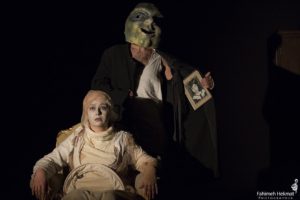
Courtesy of Mojgan Khaleghi
All the characters have changed to white-faced and half-alive dolls and dummies that in their physical and verbal expressions appear like robot-like or ghost-like creatures, waxen and non-living dummies trapped in the liminal space between the worlds of the living and the dead, who can only produce scattered cryptic expressions about the sick world they are living in. They emerge from two grave-like wardrobes which are placed vertically and sometimes horizontally, and, facing the audience, the dummies produce agonized and incoherent pleas. They move in and out of the vertical wardrobes repeatedly, giving them symbolic weight. “Hiding” and “pretense” are two constitutive elements of the performance.
The performers’ words and looks are lifeless and short as if they have been gazing into a vacuum where there is no future. The conversation between them occurs with no heat or sense of daily human relationships. Sensory continuity has been deliberately distorted, and the meaning of the words and activities has been disconnected and turned into discontinuous, reverse, mechanical tones, and sounds. Occasionally, to associate with a certain memory, for example, the memory of a party or wedding, more familiar signs are used, but even the tone of that articulation is defamiliarized. Soon the characters return in the form of half-alive dummies, and they articulate their maniac confessionary statements. The attempt has been to move on the verge of memory, nightmare, and dream in most scenes. Occasionally, in key scenes, instead of words, crows’ screams and pigeons’ obnoxious noises come from the players’ larynxes.
The occasional presence of the female director Mojgān Khāleghi on the stage, manipulating some of the performance elements, is the only active presence of a woman that reduces the obscurity of the performance and allows the audience some escape from the nightmarish space of the house. The defamiliarizing presence of the director in effect extends the limbo of the dramatic world to the audience members’ current time and place.
Mutilated hands are one of the most important symbols of the performance. Hands that can be seen as paternal or maternal hands, having lost their owners, wander on the stage and are added to the young girls’ bodies. They symbolize the lack of affection, unity, imperfection, and emotional integration.
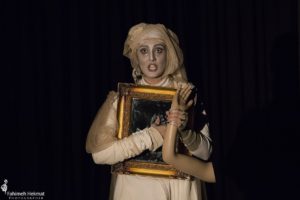
F. Bakhtiar (one of the sisters), Courtesy of Mojgan Khalegh
Music plays a tremendous role throughout the performance. The range of music selections initially seems unharmonious and discordant. We hear regional, traditional, ethnic music blended with old pop songs, birthday songs, dancing melodies and even calls to prayer. Such heterogeneity and discordance speak about the contradictions and concealed identities at the house. The presence of the father and indigenous roots is associated with local and regional music. The dead’s dancing to the birthday song and folk songs have a whimsical effect on the performance and its reception. The sound of Azān augments the geographical and eastern context of the play. However, the musical pieces are still not organically integrated, and there is room for new and better mixing. A recurring melody that can resonate with the nightmare ambiance is needed in the background to help the audiences mentally prepare for their return to reality.
This performance shares similar ideas and concepts with other performances designed and directed by young Iranian directors in the present scene of Iranian theatre. Preoccupation with nightmares, macabre ambiances, ghosts of the past, dead dummies, semi-lively faces and looks, cold and mannequin-like verbal expressions and acting, and so forth, are the sanctioned practices of the new generation of Iranian theatre-makers. Often these ideas are close imitations of Western performances and ideas without being contextualized in the current locality and temporality of Iran’s reality as well as Iranian historical and social specificity. For this reason, they are soon forgotten. These imitators should be reminded that the secret behind the highly acclaimed Iranian novelist Sadegh Hedayat’s masterpiece The Blind Owl is its skillful implementation of surrealism within the Iranian eastern context and mental framework.
Although You Were Occupied with Your Dying is inspired by the theory of Tadeusz Kantor’s Theatre of Death, it has tried to combine this concept with the concerns and crises of a contemporary Iranian family, and as an experimental play it offers a nightmarish glimpse of the women’s recurring crisis of having to play domestic roles endlessly.
You Were Occupied with Your Dying, written by Kāmrān Shahlāyi, was designed and directed by Mojgān Khāleghi and performed at Ghashghāyi Theatre, City Theatre Complex, Tehran, July 2018.
Rasoul Nazarzādeh is an Iranian theatre critic, instructor, and researcher. He has authored in Persian eight books about Iranian theatre and cinema.
This post was written by the author in their personal capacity.The opinions expressed in this article are the author’s own and do not reflect the view of The Theatre Times, their staff or collaborators.
This post was written by Rasoul Nazarzādeh.
The views expressed here belong to the author and do not necessarily reflect our views and opinions.

